Not always about math
Brand A drink is on promotion. One bottle costs $1.40, but two cost just $1.95.
Brand B drink is also on promotion. One bottle costs $1.80, but two cost $3.15.
Which is a better deal?
This can be framed as a pure math question, but this is where math is different from real-life.
Price is not always the only factor in real-life. Why is brand B more expensive than brand A? Perhaps it is higher quality?
Can we actually tell a difference?
There's where we need to read reviews or try it out ourselves.
Should we start from a cheap product and work up or the other way round?
In theory, it doesn't matter, but it does in real life.
It is a general suggestion that it is better to start cheap and work up. I've done it both ways and found that this is sound suggestion.
The reason is that it is easier for us to detect a subtle absence, so it is easier for us to detect a cheaper brand is inferior after we tried a more expensive one.
On the other hand, it is harder for us to detect a subtle presence, so we may feel a more expensive brand "feels the same" as a cheaper brand. It takes a while to realize the subtle differences.
I started with brand B. I still prefer brand B most of the time, but sometimes I cannot resist buying brand A because it's so much cheaper. :-D
Brand B is not the most expensive, btw. It is only mid-range. The really expensive ones are like $3-4 per bottle. Those are out of my price range. :lol:
More basic math
Three 250ml handwash bottles cost $7.20. Two 225ml refill packs cost $3.95.
One 250mg toothpaste costs $3.50. Two 200mg toothpastes cost $4.65.
Which are the better options?
There are actually two skills to learn here. One is to be able to do the exact calculation. The second is to be able to do a quick back-of-the-envelope estimation.
Which is the better deal?
My local bakery has these offers:
| $1.10/pc | Buy 4 for $3.20 |
| $1.20/pc | Buy 4 for $3.50 |
| $1.30/pc | Buy 3 for $3.00 |
Which is a better deal? And why, of course.
I think this is the kind of math skills we should teach kids.
Learning math in abstract is boring — unless you like math. Learning math to solve real-life issues is interesting.
Fake gold spotted
News: Fake gold hits NYC
Diamond District finds 10 tungsten-filled bars
Federal agents are investigating the peddling of bogus gold bars in Midtown.
The Post has learned as many as 10 fake gold bars — made up mostly of relatively worthless tungsten — were sold recently to unsuspecting dealers in Manhattan’s Midtown Diamond District.
The price of gold has risen more than 600 percent since January 2000, while the S&P 500 index is down 0.6 percent over the same period.
The 10-oz. gold bars are hugely popular with Main Street investors, and it is not known how many of the fake gold bars were sold to dealers — or if any fake bars were purchased by the public.
One gold dealer discovered that four of the 3-inch-by-1-inch gold bars he bought — worth about $72,000 retail — were counterfeit.
"It has the entire street on edge," said Ibrahim Fadl, 62, who has been the owner of Express Metal Refining, a Midtown gold-refinery business, for the last 11 years. "I and the others on the street work off of trust; now that trust is strained."
Fadl, a Columbia University graduate with a master’s degree in chemical engineering, and who has more than 40 years in the industry, purchased the four fake bars from a well-known Russian salesman with whom he has done business.
A second 47th Street refiner, who wished to remain anonymous, said he was burned recently when he bought six gold bars that turned out to be mostly tungsten, with just a gold veneer. He would not comment, though, on who sold him the bogus bars.
Fadl became suspicious when he offered the salesman a deep discount for the investment-grade gold bars and he quickly accepted it, a source tells The Post.
Fadl said he did his due diligence "by X-raying the bars to ascertain the purity of the gold and weighing the bars, and the Swiss markings were perfect."
Tungsten is an industrial metal that weighs nearly the same as gold but costs a little over $1 an ounce. Gold closed Friday at $1,774.80 an ounce.
To quell his suspicion, Fadl then drilled into the bar and discovered the tungsten — whose silver color is distinctive from gold’s bright yellow hue.
Raymond Nassim, CEO of Manfra, Tordell & Brookes, the American arm of the Swiss firm that created the original gold bars — with their serial number and purity rating stamped clearly into them — said he reported the situation to the US Secret Service, whose jurisdiction covers the counterfeiting of gold bars.
He said his company "is supporting and cooperating with authorities any way we can."
Nassim thought the culprit must be a professionally trained jeweler to have pulled off the caper.
"The forger had to slice the original bar along the side, hollow out the gold and insert the tungsten ingot, and then reseal and polish the bar, Nassim said.
At an industry dinner Thursday night hosted by Comex, the New York-based metals exchange, the room was abuzz with talk about the bogus gold bars, according to Fadl.
Numerous calls to the Secret Service were not returned.
One troy ounce is 31.1034768 grams, so a 10 oz gold bar is 311 grams.
Note that a gold-plated tungsten bar passes almost all gold tests — including x-ray — because its surface is real gold.
From a manufacturer who makes gold-plated tungsten alloy products:
Start with a tungsten alloy about 1/8-inch smaller in each dimension than the tungsten alloy golden bar you want, then cast a 1/16-inch layer of real pure gold all around it.
This product would feel right in the hand, and tungsten alloy golden bar would have a dead ring when knocked as gold should.
Gold-plated tungsten alloy bar would test right chemically, weigh exactly the right amount, and also pass an x-ray fluorescence scan, the 1/16" layer of pure gold being enough to stop the x-rays from reaching any tungsten.
Tungsten is chosen because it weighs extremely close to gold. Gold has a density of 19.3 g/ml; tungsten is 19.25 g/ml.
If a gold bar weighs 311 grams, then the tungsten bar will weigh 310.194 grams. That's just a difference of 0.8057 grams. I hope your scale is accurate. :lol:
Previously, to check for the tungsten, there was only the destructive drill test: drill and see if it is yellow inside.
Now, it turns out that there is a relatively simple test: ultrasound. The speed of sound in gold is 3,240 m/s, but 5,183-5,460 m/s in tungsten.
So, it is trivial to tell tungsten-filled gold bars apart from the real thing.
Personally, I don't buy this story. I highly doubt a gold dealer would use a destructive test when he can use a non-destructive test.
At the most, I believe he did not do his due diligence and got fooled by one of "for-decorative-purposes-only" gold-plated tungsten bars floating out there.
Lord of the Rings
If I were a Castle fan, I would be all over the Lord of the Rings sets. :drool:
Gandalf Arrives
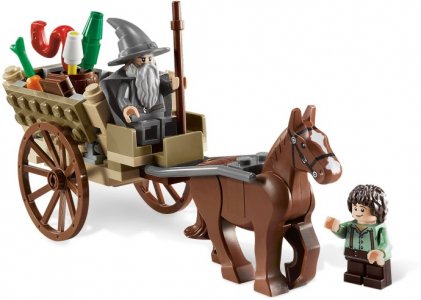
Product Shot
83 pieces, RRP S$29.90 (US$12.99).
Quite a nice set. Can be used in any civilian medieval settings, actually.
S$30 is a lot to ask for it, though. Even S$24 (20% off) is overpriced.
Uruk-Hai Army
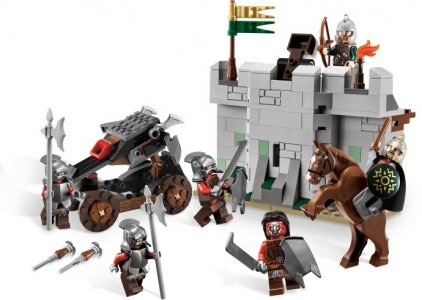
Product Shot
257 pieces, RRP S$79.90 (US$29.99).
This set is designed to be combined with The Battle Of Helm's Deep to create a more intensive battle.
It is way overpriced in Singapore.
Attack On Weathertop
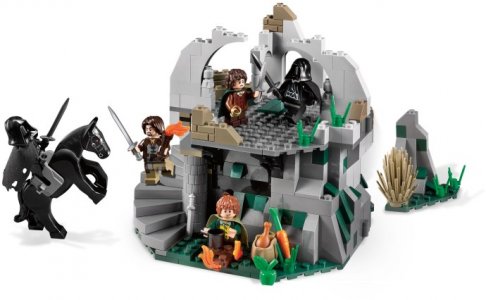
Product Shot
430 pieces, RRP S$119.90 (US$59.99).
It can be used in a civilian setting: a group of adventurers exploring a ruin which turns out to be a robbers' hide-out!
This can serve as the hidden entrance to The Mines of Moria too!
I don't see why this set is so expensive. I like it, but not at this price. Maybe can consider if it is 20% off — but it is still overpriced even then.
The Mines of Moria
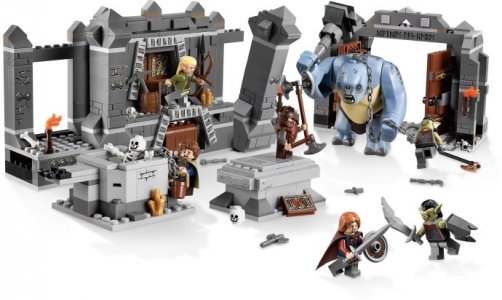
Product Shot
776 pieces, RRP S$159.90 (US$79.99).
I don't know the Lords of the Story backstory for this scene, but it reminds of me a treasure hunt in a king's tomb!
Again, this can be used in a cilivian setting: a group of adventurers uncover a forgotten king's tomb using an ancient map. Unfortunately, it is protected by the king's guardians! (I don't mind a little fantasy elements.)
Needless to say, this set is also very expensive.
The Battle Of Helm's Deep
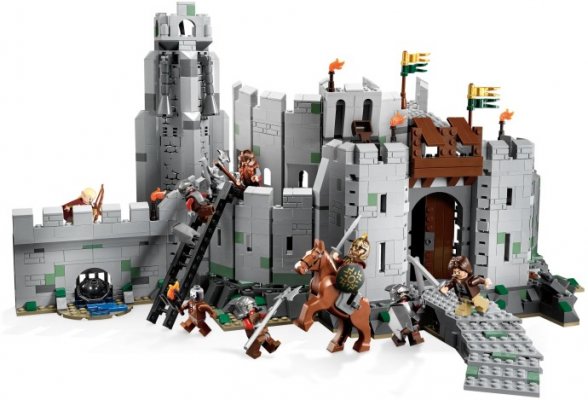
Product Shot
1,368 pieces, RRP S$279.90 (US$129.99).
A very impressive castle, but also very expensive.
The licensed premium
There are two reasons why the LOTR sets are so expensive. First, there is the licensing fees. Licensed sets are 20-25% more expensive than regular sets.
Second, for some reason, licensed sets have a higher markup in Singapore than regular sets. I noticed it previously with Harry Potter and Pirates of the Caribbean sets too.
The first reason is understandable. The second is not.
Rumors
It is rumored that the LOTR sets are not selling well, so they will be discontinued after just one wave.
If this is true, then it is better to grab the sets you like now, because it may go out-of-stock sooner than you think. However, you should also wait because the unpopular sets will be discounted heavily towards the end!
Now, LOTR is different from Hobbits. Hobbits will still continue because of the movie tie-in. That will generate sales.
However, I don't believe the rumor. I believe it's just a matter of alternating between LOTR and Hobbit releases.
But yeah, I would consider some LOTR sets if they are discounted heavily. :lol:
The case of the missing steel
News: Ghost warehouse stocks haunt China's steel sector
Chinese banks and companies looking to seize steel pledged as collateral by firms that have defaulted on loans are making an uncomfortable discovery: the metal was never in the warehouses in the first place.
China's demand has faltered with the slowing economy, pushing steel prices to a three-year low and making it tough for mills and traders to keep up with payments on the $400 billion of debt they racked up during years of double-digit growth.
As defaults have risen in the world's largest steel consumer, lenders have found that warehouse receipts for metal pledged as collateral do not always lead them to stacks of stored metal. Chinese authorities are investigating a number of cases in which steel documented in receipts was either not there, belonged to another company or had been pledged as collateral to multiple lenders, industry sources said.
Ghost inventories are exacerbating the wider ailments of the sector in China, which produces around 45 percent of the world's steel and has over 200 million metric tons (220.5 million tons) of excess production capacity. Steel is another drag on a financial system struggling with bad loans from the property sector and local governments.
"What we have seen so far is just the tip of the iceberg," said a trader from a steel firm in Shanghai who declined to be identified as he was not authorized to speak to the media. "The situation will get worse as poor demand, slumping prices and tight credit from banks create a domino effect on the industry."
VERIFY RECEIPTS
The Shanghai government's asset regulator said that it had sent a note to state-owned firms in August asking them to verify receipts for stored metal on financing deals they had with steel traders.
Police have arrested an employee from Baoyang Warehouse in Shanghai and are investigating documentation for steel stocks that the employee issued to a trading firm, said an official with the surname Ou at Baoyang. Baoyang is owned by China Railway Materials Shanghai Company Limited.
Reuters was unable to contact a member of the police force that could comment on the investigation.
The trade firm used the stocks more than once as collateral to obtain loans, said an executive at Shanghai Minlurin, another trading firm that had steel stocks in the warehouse. The receipts used were for steel worth around 380 million yuan ($59.96 million), the executive said.
Similar cases have prompted some trading houses to temporarily halt transactions related to warehouse receipts, disrupting China's steel business, traders said.
"We have suspended business for days as we are afraid we won't be able to get any stocks from the warehouses if we get a fake receipt," said one Shanghai-based trader.
BANKS BOOST MONITORING
Banks, too, are giving less credit against warehouse receipts.
"Fake warehouse receipts have become a problem for some banks and because of this, many banks have boosted monitoring of existing stocks at warehouses and temporarily stopped accepting steel stocks as collateral for loans," said a Shanghai-based branch manager from a Chinese bank who declined to be identified as he was not authorized to speak to the media.
Steel mills and end users rely heavily on trading firms to keep steel flowing from producers to consumers. Steel traders often buy consignments with full payment, ensuring cash flow to the mills. End users can buy small volumes from the traders, more convenient for them than the big volumes the mills sell.
Industry sources estimated cases that have already come to light account for about 5 billion yuan ($787.50 million) of bad debt in Shanghai, one of China's biggest steel trading centers.
At another warehouse, a logistics unit of giant steelmaker Baosteel rented a small office to a company called Shanghai Yiye Steel Trade Market Management Co Ltd. Documents were forged stating Yiye was the owner of some of the steel stored in the warehouse, said Wang Xueying, the spokeswoman for the unit called Shanghai Baosteel Logistics Co Ltd.
Yiye used the documents in dealings with two companies, China Railway Harbin Logistics and Wuhan Iron Yitong, the spokeswoman said.
The two companies came to the warehouse to collect the stocks only to find that Yiye did not own the materials, she said. The case is still under investigation, she added.
Nobody answered telephone calls to Yiye made by Reuters to request comment for this story. Both China Railway Harbin Logistics and Wuhan Iron Yitong declined to comment when contacted.
($1 = 6.3376 Chinese yuan)
The Case of the Missing Steel. That sounds like a Hardy Boys title. :lol:
This comes about everyone has gotten complacent in the modern era and ignored the age-old saying: it is not yours unless it is in your hands.
And a collateral is, can you hold on to it?
That's why might is still right in this world.
An empty Inbox at last
My Inbox was perpetually filled.
Until today.
I moved all my mails into the Unsorted folder.
Instant empty Inbox. This has only happened once or twice in my entire career. It's like the US being debt-free. It is unconceivable.
Of course, it won't last. But I got a plan.
From today onwards, I will proactively sort my emails into several categories as they come in.
I'm determined to keep my Inbox empty! :-P
On the edge
More than ever, we are living in a world that is precipitously close to war. There are now outbreaks in several parts of the world. Some may escalate to the point of no-return.
The peaceful life as we know it may come to an end.
How should one prepare for the new world?
This seems to happen overnight. All of a sudden, it seems like the world is full of ticking time bombs, just don't know which one will explode first.
Surely you are mistaken
I got to stop using tia at the end of my email. It is supposed to stand for Thanks In Advanced, but people mistake it for my surname!
And, don't call me Shirley!
A thing of beauty
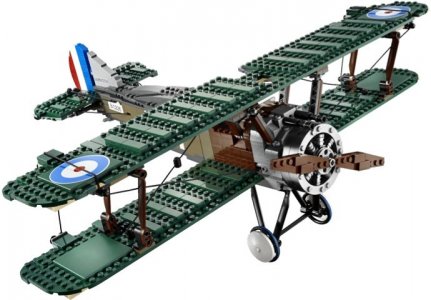
Product Shot
883 pieces. RRP S$169.90 (US$99.99).
I chanced on this while browsing the 2012 catalogue. Looks pretty good. :-)
Using LEGO to re-create real world objects/vehicles is one way to convince adults that LEGO aren't just toys for children. :lol:
Unfortunately, my entire budget is consumed by City sets — that are meant for children. :-P
Creator house 2012
There is only one house in the Creator series in 2012, which is good for my wallet! :lol:
Seaside House (2012)
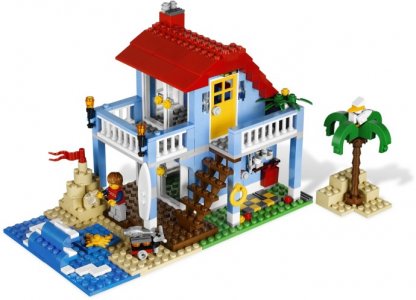
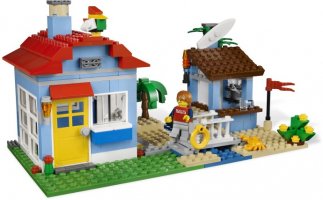
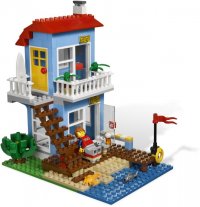
Product Shot
415 pieces. RRP S$79.90 (US$49.99).
Adds some variety to the mostly standard houses. The light-blue is quite ugly, if you ask me.
I like the first two builds, but I feel the third build is pretty close to the first one.
Two large 2012 sets to drool at
Kingdoms Joust (2012)
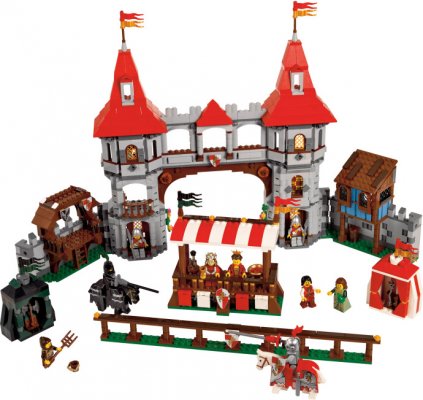
Product Shot
1,575 pieces, RRP S$249.90 (US$119.99).
The last in the Kingdom series. The most expensive and arguably the most impressive in the series.
For the first time since 1983, there is no Castle theme. Instead, there is the licensed Lord of the Rings theme.
I'm attracted by this set. However, it doesn't fit into the medieval part of the modern city landscape that I want to create.
So, pass.
(If I have infinite money, I would get it. But being money-limited, I have to choose.)
Haunted House (2012)
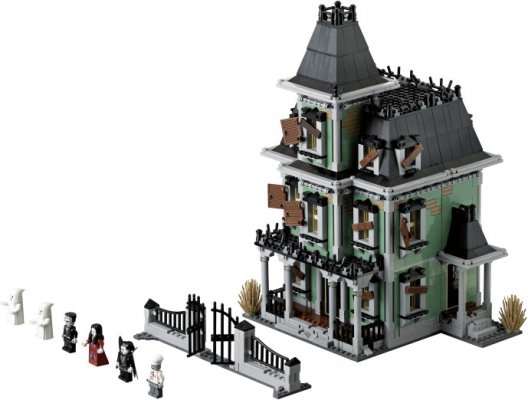
Product Shot
2,064 pieces, RRP US$179.99.
Not strictly a Modular Building, but is almost like one. And is priced like one!
I'm attracted to this set because it is a house! I would love to use it as a normal high-end "mansion" — after removing the run-down elements, of course.
But, if I were to choose between this and a normal Modular Building, I'll choose the latter. Sorry, Haunted House, pass.
(Again, limited by money.)
Winter Sets 2011/2012
Winter Village Post Office (2011)
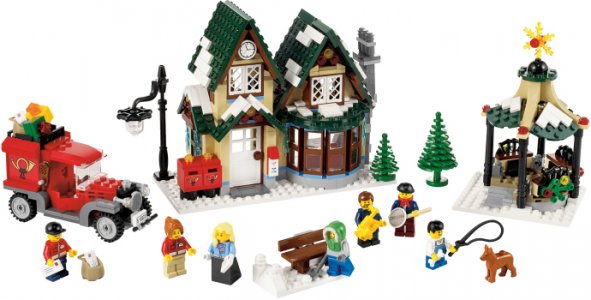
Product Shot
I just realized I never posted the 2011 winter set! So here it is.
822 pieces. RRP S$119.90 (US$69.99).
Much fewer snow. Comes with a vehicle for the first time.
I don't like the vehicle because it places the set in a modern setting. Previously, it was timeless.
Winter Village Cottage (2012)
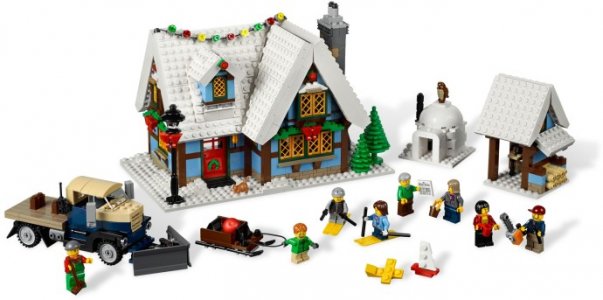
Product Shot
LEGO has announced this year's winter set. It is a bigger set (1,490 pieces), so it is also more expensive.
Based on its estimated RRP US$99.99, I think it'll cost S$170.
Very thick snow! It must be really cold to build an igloo.
This is a good set — there are many brick-built accessories, the house is larger and its interior is incredibly detailed. The only question is, is it worth the price?
At US$99.99, the winter set graduates from a medium set to a large set. Some people speculate that this is the last big set for the series — it is LEGO's tradition for the last in a series to "go out with a bang".
But part of the increase in price could be simply due to the weakened US dollars. In general, FY12 sets have higher RRP.
Comparing the sets
| Set | Year | $ | #Pieces |
|---|---|---|---|
| Winter Toy Shop | 2009 | US$59.99 | 815 |
| Winter Village Bakery | 2010 | US54.99 | 687 |
| Winter Village Post Office | 2011 | US$69.99 | 822 |
| Winter Village Cottage | 2012 | US$99.99 (est) | 1,490 |
Some people use $/piece to determine if a set is worth it. However, this only works if the pieces are more-or-less the same size.
In some sets, such as the Winter Village Cottage, there are large numbers of 1x1 tiles that inflate the piece count, but they are very small, light and cheap!
It's time to look at both $/piece and $/gram.
HDB flat hits S$1 million — maybe
News: S$200,000 COV record could be broken soon
The cash-over-valuation (COV) component in HDB resale transactions is rising and it could hit over S$200,000 soon.
COV refers to the sum of cash that needs to be paid by a buyer over and above the market valuation of a flat.
Real estate agents said the median COV paid for HDB resale flats has risen by about 12 percent to S$30,000 in the third quarter so far.
But for a Bishan unit, the COV has hit a record high of S$200,000. The executive maisonette at Bishan Street 13 was sold for S$980,000 including the S$200,000 COV.
Mr Lee Sze Teck, senior manager of training, research and consultancy at Dennis Wee Group, said: "Our agents actually closed a couple of deals in Bishan, one with about S$200,000 COV, the other S$250,000 COV. Both are for executive maisonettes."
Once the sale is completed, the S$250,000 COV will surpass the S$200,000 paid for the Bishan unit at Street 13.
"There is another on-going transaction in Queenstown, where an executive maisonette is transacted at S$1 million and the COV is S$195,000. According to the buyer, he has bought into this unit because of the fengshui and also for the unblocked view from the bedroom," added Mr Lee.
Property agents said those who pay high COVs are typically buyers who are downgrading from private landed properties.
Six-figure COVs are very rare and only for choice units with excellent attributes, they said.
Market watchers said these large price tags are not likely to swing HDB resale prices significantly, because there are not many such cases.
Overall, they said HDB resale prices are inching up because valuation has been climbing. Prices could go up by some 1.5 percent this year, they added.
The COV portion is also likely to trend higher, as more buyers are entering the market, especially for attractive units in mature towns, said property agents.
ERA's key executive officer, Eugene Lim, said: "We do see significant increases. For example, in towns like Bishan, Queenstown, Toa Payoh, you can see COV increase at a median level of between 30 and 40 percent between the second quarter and third quarter. This is more than double of the norm."
For the third quarter, analysts expect a total of 6,800 to 7,000 units of HDB resale flats to be sold - similar to the number of deals done in the second quarter.
Real estate agents advise buyers to be prudent and consider the upside potential of any home purchase as it is a long-term commitment.
Another consideration is the large supply of new HDB flats that will come on-stream in the next few years.
ERA's Mr Lim said: "If you factor in the 3-year construction, 5-year minimum occupation period (before an owner can sell his flat), in about 8 years, you are going to see a lot more flats which will be eligible for resale. So, what impact will that have on resale prices in the years to come?"
Home buyers should also think about whether they will be able to ride out the market cycle if the economy hits a bad patch.
Hot on the heels of the $980k EM flat is another EM flat that could be sold for $1 million — if it goes through.
It looks like it'll take at least $900k to buy an EM with a sky-terrace.
(Valuation at $780k means you need to come up with $198k in cash — $78k for the 10% and $120k COV.)
I wonder if the buyer knows about the 99-year lease? Some of these EMs are pretty old — around 30 years.
Flushed with cash
News: $808,080 HDB sale hits the roof
Just how much are people willing to pay for an HDB flat?
Mr Freddy Choo paid $808,080 for his executive maisonette in Tampines.
Worth every cent, he said.
The price includes a whopping $168,080 in cash over valuation (COV).
That's among the largest COVs paid since the financial crisis in 2008, said real estate agents.
One of the previous reported highs was about $200,000 for an HUDC flat in Shunfu. It was sold at $1.1 million in July, 2010.
Mr Choo, 46, said he was willing to pay a premium as his new home was renovated just five years ago and came fully-furnished.
The real estate agent had come across the unit, on the eighth storey of Block 146, Tampines Avenue 5, in April.
The 150 sq m flat is two bus stops away from the Tampines MRT station and Tampines Mall.
Mr Choo said it was valued at $640,000.
The median resale price of executive flats in Tampines was $640,000 as of the second quarter of 2012, according to HDB's website.
The father of two said the final amount — $808,080 — was also an auspicious number.
It is the highest price paid for an executive HDB flat in Tampines in the past year, according to HDB's website which shows transacted prices.
Mr Choo is married to another real estate agent, and they have a daughter, nine, and a son, 13.
Mr Choo said his family had previously owned a condominium penthouse in Geylang, which he sold for $1.4 million.
To pay for his new place, Mr Choo has taken out a 24-year loan of $560,000, saying: "You can always earn more money.
"But it's not easy to find a suitable flat which you can call home."
"I searched for a month and looked at six units before I decided on this one."
The block is about 600m away from St Hilda's Secondary which Mr Choo's son attends.
His daughter, Schermaine, attends the nearby St Hilda's Primary School.
She said: "I can walk to school in 10 minutes. There's also a park, shopping mall and playground nearby for me."
Mr Choo's family was also drawn by the extensive renovation to the unit.
He said the previous owner had spent $200,000 and had fittings such as a water feature in the living room, and glass banisters.
And Mr Choo claimed the owners left behind furniture worth $100,000. Some of the furniture they included a custom-made bed, Japanese-style tabletop and a Swarovski crystal chandelier worth $3,000.
They also left electrical appliances like a flat-screen TV, fridge and speakers.
Said Mr Choo: "They were also a Singaporean family who upgraded to a condominium. They initially wanted a COV of $240,000, but I managed to bargain down."
The previous owners could not be contacted as Mr Choo said he does not have their telephone number.
The transaction was approved in May and Mr Choo's family moved in two weeks ago.
He said: "All my friends who have seen my place say it is worth the amount I paid."
Good buy?
Mr Albert Lu, key executive officer of property firm C&H Properties, told TNP: "On the surface, the figure definitely looks like a lot.
"But if what Mr Choo says about the renovation and furnishings is true, it is actually a good buy."
Most flat owners, he said, spend under $100,000 on renovations.
"For someone to spend $200,000, the renovations would have been very 'high-class'."
Mr Mohamed Ismail, chief executive officer of PropNex, agreed.
He said: "In this case, the transaction seems value-for-money, considering the value of the renovation and furnishing the previous owner left behind."
COVs have exceeded $160,000 before, said Mr Ismail. For example, he encountered two such flats — one in Yishun and another in Jurong East — in 1996.
Indeed, it was previously reported that resale prices had hit a high in 1996, with the median COV going as high as $42,000 in the third quarter of 1996.
Since the economy recovered after the 2008 financial crisis, it is possible for some COVs to have returned to such "spikes", Mr Ismail added.
Mr Chris Koh, director of property firm Chris International, said Mr Choo's case is the largest COV transaction he has come across since 2008.
It was previously reported that in 2007, some home-owners were asking for COV sums of more than $150,000 in certain mature estates.
"But if the flat was well-renovated and well-furnished, as claimed by Mr Choo, I can understand why he agreed to pay such a large amount of COV."
Half of all flats sold are renovated, he estimated, but only about 20 per cent have good furniture for buyers to use, he said.
"Most owners tend to bring their furniture along with them when they move out."
Only about 5 per cent of all flats can command such high COVs, he added.
All three did not think this case was reflective of housing prices in general.
Mr Koh said: "This is a resale flat, which is more expensive than a Build-to-Order (BTO) one.
"The BTO flats are still affordable, and there are many schemes to help young couples get these flats quickly."
For example, a four-room flat in Tampines Alcoves and Tampines Green Terrace — BTO projects launched earlier this year — was reported to cost $292,000.
Mr Ismail warned that the transactions like Mr Choo's are "one-off" and are not reflective of general prices.
He said: "It would not make sense to pay such large COVs for flats which do not have comparable furnishings and renovations."
COVs have fallen to an average of $25,000 island-wide, he noted, so buyers should exercise caution before paying large amounts over valuation.
"They should also remember that if the property market corrects itself, like during an economic downturn, whatever COV you pay will mean nothing."
This was actually an earlier news. The flat is only valued at $640k. It looks like the valuation does not consider the renovations done at all.
Paying $168k COV seems excessive at first, but after thinking about it, I think it's quite an okay deal.
Let's say Mr Choo already plans to spend $100k on renovations and $30k on furnishings. That means his real COV is only $38k!
(These are excessive amounts to pay, but suppose Mr Choo really wants a high-end place.)
He would pay cash for these anyway to avoid the high interest rate. Instead, he would take a higher housing loan to take advantage of the current low interest rates.
One thing I don't understand is that 80% of his valuation is only $512k. How can he borrow $560k?
$20k to a million!
News: Bishan HDB executive maisonette changes hands for record $980,000
Despite its steep $980,000 asking price, a Bishan executive maisonette was snapped up on the first day of an open house held to sell it.
The buyers are a Singapore citizen and her Chinese-national father, and the seller is a Singaporean woman who is relocating to Shanghai for work.
The price tag makes this the most expensive Housing Board (HDB) resale flat sold. The last record was held by an executive flat in Toa Payoh, which was sold for $910,000 in May this year.
The $980,000 includes a $200,000 cash over valuation (COV), which is a premium paid to the seller in cash. It is also believed to be the highest ever COV reported.
ERA Realty's Cheryl Clare Ng, the agent of the Bishan seller, said 40 people viewed the 25-year-old property in Bishan Street 13 within the first two hours of the open house in June.
Its simple furnishings did not deter the buyers.
Instead, they were won over by how it is a spacious 1,800 sq ft and comes with a rare 150 sq ft open roof terrace.
Other attractions, Ms Ng noted, are its proximity to amenities such as schools.
The Bishan bus and MRT interchange is less than a 10-minute walk away.
"It's also on the 19th floor, has a great view and it is very airy most of the time," she said.
Dennis Wee Group property agent Thomas Hee, who represented the buyers, said such spacious maisonette units with open terrace roofs are hard to come by. There are only 48 such homes islandwide, he said.
In 2005, a unit like this would have cost about $550,000.
"When they are put up for sale, they're always snapped up," said Mr Hee. "In this case, the buyer was able to meet the owner's expectations very quickly."
Yesterday, buyer and seller met at the HDB Hub for staff to vet documents and do eligibility checks.
The process is expected to be finalised within two months, and both parties parted ways with smiles on their faces.
Ms Ng said the buyers got a good deal: "If you compare it to a similar condo unit, you are effectively paying half the price for twice the space."
The $980,000 price equates to about $550 per sq ft.
A similar-sized condominium unit nearby would fetch at least $1,300 psf.
Property analysts, however, were quick to point out that the record-breaking deal is a one-off that is unlikely to drive up resale flat prices or COV quantums.
ERA Realty key executive officer Eugene Lim said he is not surprised that the Bishan unit fetched a high price since such homes are rare and flats in the area usually command a premium.
Most home hunters The Straits Times spoke to, however, baulked at the small fortune paid for the Bishan unit.
Said receptionist Agnes Ho, 34: "It is a very big investment to fork out, particularly if it's in cash."
But some saw it as a sound investment. Civil servant Andrew Wong, 28, said: "Essentially, you are also getting all the conveniences of a good location at a fraction of the price."
Valuation is $780k, which isn't cheap either.
$550k was a lot to pay in 2005, but it was cheap in hindsight! 5-room flats in good locations now fetch more than that!
HDB prices spiked after 2007. Years of limited supply, increased demand from new PRs and their willingness to tap their CPF fully — which, in hindsight, was the right thing to do.
Although we think that $980k is very expensive for a HDB, the situation changes if we compare to a condo. Suddenly, it seems very reasonably priced! (Especially if we prefer living space over facilities.)
The issue here is the $200k COV.
What is valuation? It means how much professional appraisers think the flat is worth.
And you want to pay 25% more? Crazy.
Comex Show 2012 attendance
| 2008 | 725,000 | $56 mil |
| 2009 | 710,000 | $63 mil |
| 2010 | 815,000 | $68.5 mil |
| 2011 | 822,000 | $70 mil |
| 2012 | 830,000 | $73 mil |
Someone questioned if this year's figure is a bit too high.
Well, the bubble has to burst at some point. This would have been a good year to do so, but I think they still want to maintain the illusion.
Tell-tale signs: only two halls, half of one hall is non-IT, reduced human traffic.
Next year, perhaps?
The shopping experience
We shop for the ingredients in a store, of course:
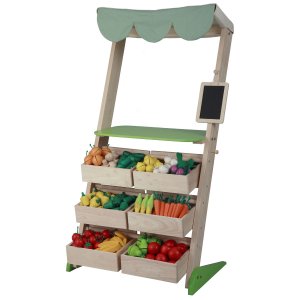
This PlanToys Market Store may look simple, but it costs US$175! :-O The good news is that we should be able to DIY it at a fraction of the price using parts from IKEA.
And we need a shopping cart:
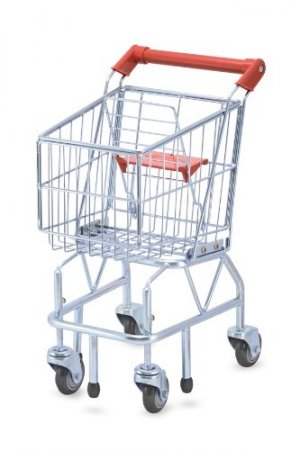
The most realistic shopping cart, by Melissa & Doug. It is actually made of steel. It also costs a jaw-dropping US$48.95. I think I'll give it a miss.
Shopping time!
Before we can prepare the food in the kitchen, we need to buy the ingredients first.
Learning Resources Farmer's Market Vegetable Set

US$9.99.
Consists of carrot, corn, cucumber, green pepper and tomato.
Learning Resources Farmer's Market Fruit Set
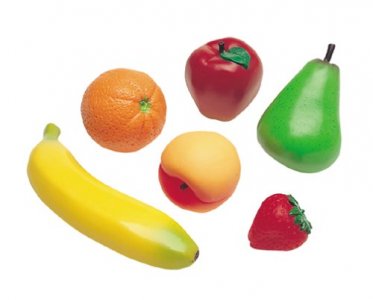
US$12.97.
Consists of apple, banana, orange, peach, pear, and strawberry.
Learning Resources Fruit and Vegetable Play Food Basket
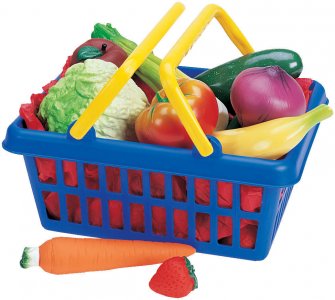
US$17.40.
Consists of apple, banana, carrot, celery, cucumber, green pepper, lettuce, pear, red onion, strawberries (2x), tomato and a basket.
All the vegetables and fruits are life-size except for the lettuce.
Melissa & Doug PlayTime Veggies
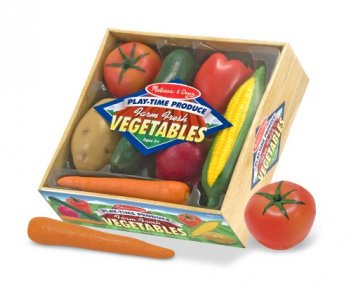
US$13.11. 7 pieces.
One class higher. Said to be realistic, life-size and tough!
Cons: chemical smell when new.
Melissa & Doug PlayTime Fruits
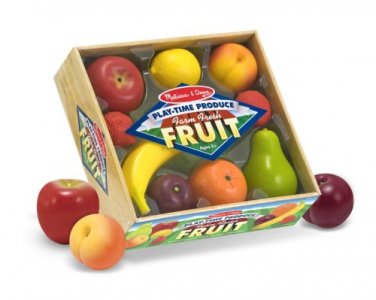
US$15.17. 8 pieces.
Melissa & Doug Bulk Fruits & Veggies
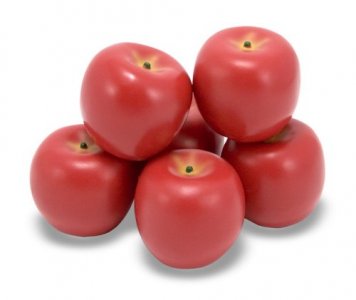
US$10-$18. 6 per pack.
I can't seem to find the full list, but these are available: apple, banana, carrot, corn, cucumber, lemon, nectarine, orange, pear, pepper, tomato.
I think this is for people who want to create a grocery store. :lol:
However, it may be cheaper to buy multiple sets of the PlayTime Veggies and Fruits instead.
Melissa & Doug Food Groups
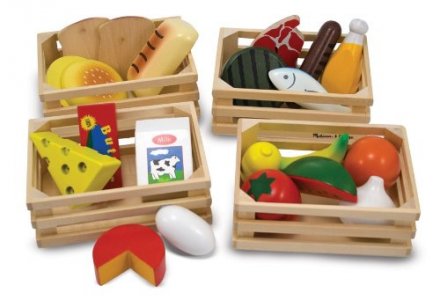
US$16.74.
This set is much less realistic looking, but it is made of wood and has a theme of four food groups: grain, meat, dairy and veggie/fruit. Comes with four small crates.
Cons: not realistic and not durable.
Army Builder
I'll say a decent grocery store needs 3-5 of each fruit/vegetable. That is very expensive. If we get 5 sets of M&D PlayTime Fruits, that would be US$75.85 already! I don't think I even spend so much on real fruits in a year!
There is only one solution: look east. ;-)
On Tao Bao, a simple set costs just 10 yuan. That's just S$2! A realistic fruit costs 3 yuan, so 8 of them would cost just S$4.80. That's four times cheaper!
(Although Learning Resources and Melissa & Doug play fruits are made in China, I can't find them at local prices. The re-imported sets are super expensive!)
I don't need the fruits/vegetables to be super realistic. Just need to be realistic. There are other considerations such as toxic chemicals, choking hazard and whether the toy can survive tough handling.
Compulsary land acquisition strikes again!
News: Making way for the new Thomson Line
Some residential and commercial properties will be acquired for the construction of the new Thomson MRT Line.
The post office along Upper Thomson Road will be one of them. It was opened 54 years ago.
The next closest post office for the area is at the Bishan Community Club.
But to many patrons, what's special about the stand-alone Thomson Road Post Office, is the ease and convenience of doing business there.
"There're parking lots for us, maybe for a while, like... five to 10 minutes. If they rebuild a new post office with a parking space, that would be good for us," said one patron.
"Occasionally I come here, I do not live around this area... (The post office) has been around for a long time and I have over the years been coming here. I would kind of miss it," said another.
One of the more iconic buildings in Chinatown, Pearls Centre, will also be torn down to make way for the new Thomson Line.
Pearls Centre has been around for some 40 years.
The 243 tenants have about two years to move out.
But some of the 44 residents Channel NewsAsia spoke to were surprised at the announcement, as they had recently renovated their units.
The Singapore Land Authority said compensation will be pegged to the market value of the property as determined by professional valuers.
But some tenants are worried the compensation would be lower than what they would get, if the building had gone en-bloc.
Christina Sim, director, Residential, Cushman and Wakefield, said: "Certainly when a development goes en-bloc or collective sale, there is a premium attached to what a property seller would be able to command if it is sold on an individual basis and certainly much so if it is compared to a compulsory acquisition."
Ms Agnes Low, a resident at Pearls Centre, said: "If the government gives us a price that is not acceptable, of course we will not agree to sell off. Of course everybody wants to make money."
Bryan New, a shop tenant at Pearls Centre, said: "It's really not a shock to me because I heard from some of the tenants that the management is trying to do an en-bloc for the whole building, but what I didn't expect is the government (coming) in."
MP for Tanjong Pagar GRC, Indranee Rajah, will meet tenants of Pearls Centre on Saturday to better understand their concerns about having to move out within the next two years.
Ms Indranee said the next two days will give business owners and residents time to digest the news.
Her greatest concern is for those using their units as a home, who now need to find another place.
She said the Singapore Land Authority will do its best to facilitate, but stressed it's not like the Selective En Bloc Redevelopment Scheme, where there is a replacement unit.
"In any land acquisition... your compensation (will be) the market value of the unit. It is not for the replacement unit. So I quite clearly understand how they think and feel about it. So the question is, what is the next best thing that can be obtained for them. Because I fully understand the feelings especially if you've stayed there for many years of your life. It's not just the physical place, it's the whole atmosphere," she said.
The Thomson Post Office may be an old building (1958), but it is also very drab and has no historical value, so I don't think anyone would miss it.
But, take a guess why there aren't many old buildings in Singapore? Because they are torn down all the time!
Just beside the post office is the famous Roti Prata House. I sure hope they own the shophouse... or I guarantee that they won't be there anymore.
Ms Agnes Low tells the best joke. Refusing to sell if the price is not acceptable? Hello, this is compulsary land acquisition! SLA call the shots.
Debt death spiral
| Year | Debt (US$) | |
|---|---|---|
| 1863 | 1,119,772,138.63 | Crossed US$1 billion |
| 1918 | 14,592,161,414.00 | Crossed US$10 billion |
| 1943 | 136,696,090,329.90 | Crossed US$100 billion |
| 1982 | 1,142,034,000,000.00 | Crossed US$1 trillion |
| 2008 | 10,024,724,896,912.49 | Crossed US$10 trillion |
| 16 Nov 2011 | 15,000,000,000,000.00 | |
| 28 Aug 2012 | 16,000,000,000,000.00 |
The US took 200 years to accumulate its first trillion in debt. Today, it added US$1 trillion in just 286 days.
It just gets shorter and shorter...
A parallel North-South MRT line
News: Thomson Line to open from 2019 with 22 stations
Singapore's sixth rail network — the Thomson Line (TSL) — will open from 2019, instead of the indicative timeline of 2018 announced in the Land Transport Master Plan.
Minister for Transport Lui Tuck Yew, who gave an update on the Thomson Line on Wednesday, said the change in timeline is to accommodate some adjustments made to the original plan.
Under the final rail alignment plan of the Land Transport Authority (LTA), the TSL will be longer and have more stations.
It will be 30 kilometres long — 3 kilometres longer than envisaged — and have 22 stations, four more than originally planned.
One of them is Springleaf station, sited in Nee Soon Group Representation Constituency (GRC).
Ms Lee Bee Wah, an MP for the area, said: "(At) Springleaf, most of the residents there are living in private estates, landed properties as well as some condominiums. Currently, the nearest station is Khatib MRT and the complaint is that it is so near and yet so far, because there is no direct bus service. (With the TSL)...we don't need to have direct bus service, there will be a station there."
Another two stations are Woodlands North and Woodlands South in Sembawang GRC.
Ms Ellen Lee, an MP for the area, said: "It (TSL) will facilitate transfer, especially within the estate itself and it will solve the crunch that my residents feel whenever they take the MRT and when they take the buses."
TSL will run from Woodlands in the north to Marina Bay in the south and is expected to be built at an estimated cost of around S$18 billion.
It is expected to have a daily ridership of 400,000 commuters.
Six of the 22 stations will be interchanges, enabling commuters to reach their destinations in the shortest possible time.
For example, a resident of Sin Ming travelling to Republic Polytechnic in Woodlands will halve his or her commute time from 50 minutes to 25 minutes.
Another at Woodlands Regional Centre heading to Marina Barrage will take 55 minutes instead of 70.
With six interchange stations, the TSL will connect to all existing lines and the future Downtown Line (DTL).
"All in, about 160,000 households will be within 10- to 12-minute walk from one of these stations. So you will have an additional option. Instead of having to take a feeder bus or find a way to get to one of the stations on the North-South Line, these 160,000 households can choose to walk to one of the Thomson Line's stations as an alternative," said Mr Lui.
TSL will connect to the North-South Line at Woodlands and Orchard stations.
Caldecott Station will connect to the Circle Line.
Residents of the Bukit Timah stretch can change trains at the future DTL Stevens Station to connect to the TSL.
The Outram Park Station will connect the TSL to the East-West Line and North-East Line, while the Marina Bay Station will connect the TSL to the North-South Line and Circle Line.
TSL will open in three stages from the north to the south.
Phase One, which will have three stations from Woodlands North to Woodlands South, will open in 2019.
Phase Two will be ready in 2020, with stations from Springleaf to Caldecott.
The final stretch of 13 stations from Mount Pleasant to Gardens by the Bay will open in 2021.
When fully operational, an estimated 60,000 households will be within 400 metres of one of the TSL stations.
The line, which will be fully underground, will run on a four-car instead of a three-car system.
Mr Lui said this will give it additional capacity to cope with any increase in long-term demand.
He was speaking during a visit to Telok Ayer Station of Downtown Line One, which will open by the end of next year.
Mr Lui also said: "During the construction phase (of the TSL), there will inevitably be a certain amount of inconvenience, noise pollution. We will try our best to minimise this as much as possible. We will of course want to engage the residents, dialogue with them, find ways to meet as much as possible some of the points that they raise."
LTA, Singapore Land Authority (SLA) and the Urban Redevelopment Authority (URA) said in a joint statement that while all efforts have been made to minimise land acquisition, the government will acquire four full lots.
They include Pearls Centre in Eu Tong Sen Street, a post office along Upper Thomson Road and two landed properties along Stevens Road and Robin Close.
Pearls Centre will be affected by the construction of the TSL as a tunnel will run under part of the building.
To optimise land use around the future TSL station at Outram Park, Pearls Centre will be acquired and integrated with the adjoining state land for a high-density mixed-use development.
Five other part lots will also be acquired but will not affect the main building structure.
Affected parties will be compensated and the amount will run into a few hundred million dollars, said SLA. The money will come from the S$18b budget to built the line.
The SLA gazetted the land affected by acquisition on Wednesday.
I must say the two landed properties along Stevens Road and Robin Close are really suay. All their neighbours will stay put... but them.
Just like Rochor Centre before it, Pearls Centre will be no more. This is Singapore's underhand method to acquire prime land.
"Fellows, I'm going to take over this land. You don't have a choice. Don't worry, I'll pay you the current market value, which is low because your property is run-down and the area isn't developed yet. When I develop the land in future, it's going to be worth 5 times more! But none of you have a share in that. Mwahahahaahhaha!"
It just rubs me the wrong way.
Back to the MRT line. Do we need another MRT line? 10 years of inconvenience and S$18 billion to serve 400,000 commuters. That's S$45k over the life of each commuter. If a commuter spends $4 per day, it'll take 30 years to break even!
List of Step2 kitchens
| Kitchen set | US$ | S$ | #Acc | #Elec | Weight | Vol |
|---|---|---|---|---|---|---|
| Deluxe Kitchen Play Set | $281.28 | 162 | 5 | 83.75 lbs | ? | |
| Grand Walk-In Kitchen & Grill | $260 | 103 | 3 | 50 lbs | 237 kg | |
| Deluxe Kitchen | $220 | $980 | 38 | 5 | 70 lbs | 120.1 kg |
| Grand Walk-In Kitchen | $220 | $1,125 | 100 | 3 | 55 lbs | 214.1 kg |
| Fresh Market Kitchen | $200 | $840 | 47 | 4 | 43 lbs | 176.3 kg |
| PartyTime Kitchen | $150 | $690 | 33 | 4 | 32 lbs | 79.8 kg |
| 50's Diner | $140 | 54 | 3 | 30 lbs | 98.6 kg | |
| Dream Kitchen | $140 | $690 | 37 | 4 | 42 lbs | 67.3 kg |
| Master Chef Kitchen | $140 | $660 | 36 | 4 | 33 lbs | 82.1 kg |
| Legacy Kitchen | ~$130 | 28? | 2 | 34 lbs | 82.1 kg | |
| Gourmet Cafe Kitchen | $120 | $450 | 40? | 1 | 26 lbs | 53.6 kg |
| Welcome Home Kitchen | ~$100 | 9? | 1 | 36 lbs | 44.4 kg | |
| Custom Kitchen | $90 | 20 | 1 | 31.5 lbs | 44.2 kg | |
| Fresh Accents Kitchen | $90 | $395 | 30 | 2 | 20 lbs | 39.3 kg |
| New Traditions Kitchen | $90 | $400 | 29 | 2 | 21 lbs | 39.3 kg |
| Prepare & Share Kitchen | ~$90 | est $370 | 41 | 1 | 27 lbs | 54 kg |
| Modern Lines Kitchen | $80 | $495 | 19 | 3 | 30 lbs | 36.3 kg |
| Cozy Kitchen | $60 | 21 | 0 | 14 lbs | 22.8 kg |
Bold indicates sets that I am interested in.
Singapore prices from J-Kidz. I wonder how they price the kitchens — they are not consistent with the US price.
Kitchen playsets
Mention kitchen playsets and the first impression is, aren't they for girls?
That is a common perception, especially if we go Kiddy Palace or Toys R US, where the entire kitchen section is in the most girly pink color we can imagine.
Those are not the kitchen sets we are looking for.
Step2 and Little Tikes have pretty well-made plastic kitchens with electronic features.
(Wood kitchens look even nicer, but they usually don't have electronic parts.)
Modern Lines Kitchen
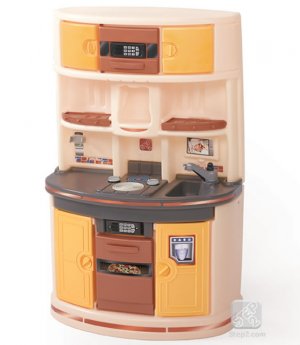
The Step2 Modern Lines Kitchen is a pretty basic model at US$80 — although it is listed at US$120 at US Toys R US.
It looks pretty neat and clean. I like it.
J-Kidz brings these big stuff into Singapore. They list this at S$495! :-O
Prepare & Share Kitchen

The Step2 Prepare & Share Kitchen looks good too, though it lacks a microwave. It is a US Toys R US exclusive (US$90).
J-Kidz says it is bringing it in September. They say it should cost about S$370.
Master Chef Kitchen
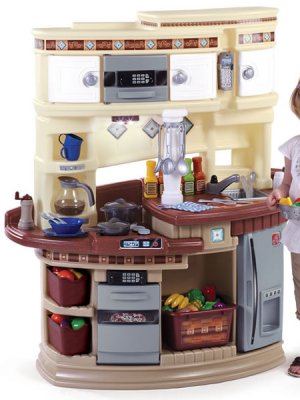
The Step2 Master Chef Kitchen is slightly bigger. It has a lot more storage area and looks more like a complete kitchen.
It is one grade higher at US$140. J-Kidz sells it at S$660.
The biggest play kitchen
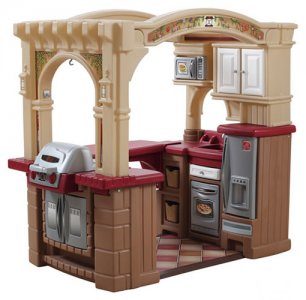
There is no bigger play kitchen than Step2's Grand Walk-In Kitchen & Grill at an eye-popping US$260.
(It costs over S$1k by the time it gets to Singapore!)
It has a grill, stove top, sink, microwave, fridge, cupboards, flooring and a 103-piece accessory set.
But the thing that differentiates it from other kitchen playsets is its walk-in feature. It is more like a small playhouse than a kitchen!
It is impressive, but it requires a lot of space. And the walk-in area isn't that big — it's a tight squeeze for two children. So, it isn't really as big as you think it is.
I'll take a standard kitchen playset instead.
A big home for a baby

The Fisher-Price Laugh & Learn Learning Home is a large toy with many playable parts. It is really just a door. But it is very big for a baby!
The Learning Home was released in 2004 and is still available today; it should be a good seller. Most reviews are full of praise for it.
Its RRP and street price are US$90 — most likely due to its size. Shipped volumetric weight is 9.6 kg; 560 kg after assembly.
Due to its size, it is infeasible to ship it from overseas, so the only possibility is to get it locally.
Unfortunately, the Learning Home is quite hard to find locally. Very few places carry it — or carry it anymore. I guess it is not popular — too big and expensive.
But it is available for SS$270. But as we know, it should cost around S$180 based on the 2x ratio. No wonder it is still available. Indeed, one retailer sold it for S$200, but is out-of-stock now.
Second hand
Second hand units pop up a few times a year. A working one in good condition goes for S$100-120. Working but okay condition goes for S$80. A non-working (electronics) one goes for S$60. Take your pick.
Rental
It is also possible to rent the Learning Home for S$35 per month!
Suppose we buy a new unit at S$200 and are able to sell it away at S$100 easily, $35/month means the break-even point is 2.86 months.
Will the baby get tired of it in that time? If it is, then it is better to rent. If not, it is better to buy.
Looks like even buying toys require some financial planning. :lol:
No fooling the global shopper
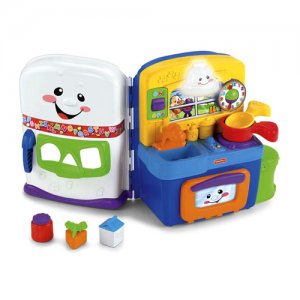
The Fisher-Price Laugh & Learn Learning Kitchen is a medium-sized toy with many playable parts. Unfortunately, it retails at S$120, which makes it a pretty high-end toy.
But is it really a high-end toy?
The US Fisher-Price website lists it at a Recommended Retail Price (RRP) of US$38. But the street price is lower. For example, the US Toys R Us website lists it at just US$25.
Based on other Fisher-Price products, the local price should be around 2x of the US RRP, so the Learning Kitchen should cost just S$76.
I thought it would be a decent deal if it is available at 20% off (S$96) — which happens a few times a year. Imagine my surprise when I saw it on a special promotion for just S$70!
(In other words, the 2x ratio holds.)
The normal retail price is just unbelievable "chop-carrot".
The Learning Kitchen is worth considering at $70, but is not a good deal at all at S$120.
The moral of the story? Check the US price first. Local prices may be over inflated. (It's tough to be a local retailer.)
The pink discount
Missus wanted to get a USB thumb drive. We just looked for the cheapest one since she had no requirements.
We saw a 8 GB awful-pink color SanDisk thumb drive selling for $7.50. In contrast, the regular ugly red-black version — also SanDisk — was selling for $9.90.
Wow, what a difference. Let's get the pink color one, Missus said.
I was skeptical the color alone could make such a price difference.
I asked the sales assistant if there were any difference between the two. He said they are identical.
But the price, I asked?
He was surprised too. He took the regular version for a price-check. $7.50!
We bought it.
Aboard Titanic
Sometimes, I wonder how was it to be like on board Titanic?
After it crashed with the iceberg, it took so long to sink that it must have felt unreal at first. Just a gentle shake and a gradual tilt. Surely it wasn't serious?
But it was fatal and there was no stopping physics. The Titanic sank in 2 hours and 40 minutes.